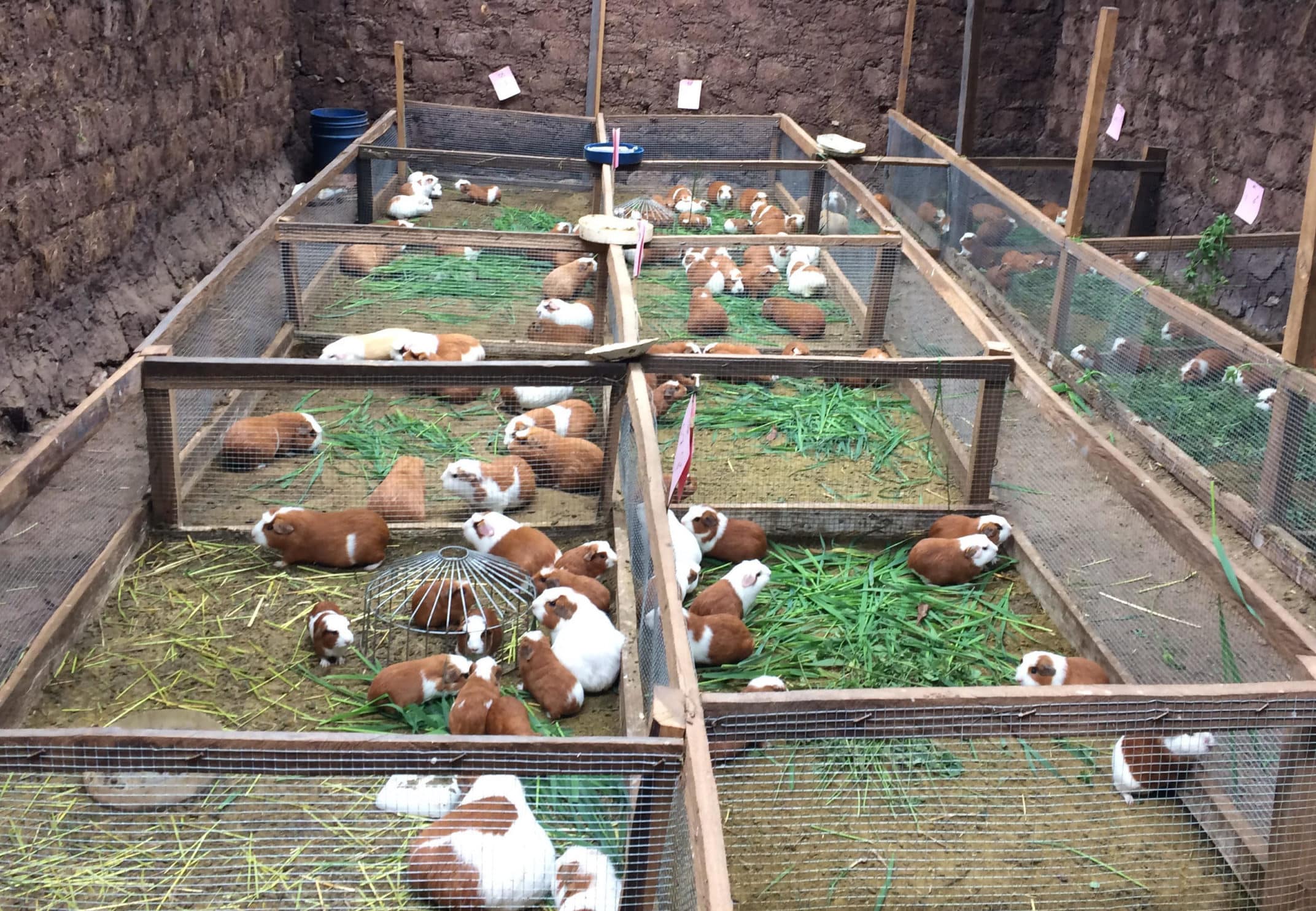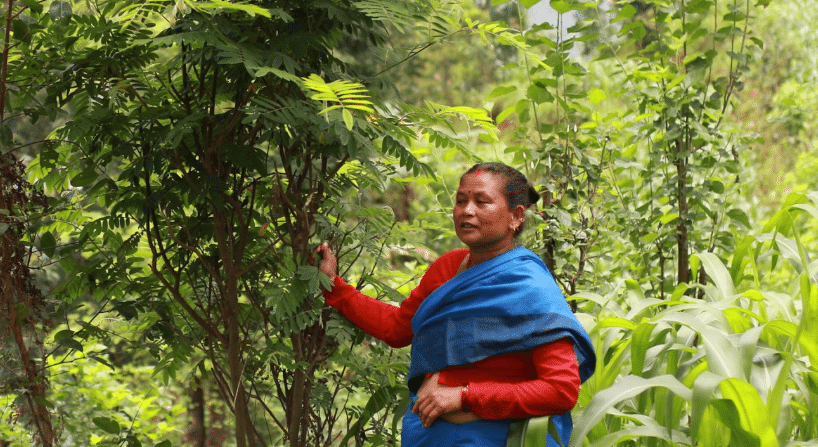
Bamboo Is a Salve for Impoverished Nepal
June 7, 2022
In Peru, Guinea Pigs Help Insulate Farmers From Economic Shocks
July 11, 2022Return to Agroforestry Empowers Women in Nepal

- Although farmers traditionally practiced agroforestry in Nepal, they gave it up with the advent of the green revolution.
- A women’s group in Kavre district decided to return to agroforestry four years ago, and they are already seeing the benefits.
- The program is not only helping conserve soil nutrition and promote food security, it is also empowering women.
KAVRE, Nepal – Srijana Karki still remembers her childhood when she visited her grandfather’s farm. “The green fields were dotted with various fruit trees and we would get to eat different varieties of fruits from the farm,” Karki, South Asia director at the NGO World Neighbors, says.
But these days, when she visits the farm, she finds that the trees have gone missing.
“Following the green revolution, farmers were encouraged to practice monoculture and use a lot of chemical fertilizer,” said Karki. “They were led to believe that the trees only occupy space and add unwanted shade to the farm,” she added.
However, globally and in Nepal, the notions propagated by the green revolution are being challenged by agroforestry, a system that combines trees with shrubs, crops, and livestock in a system that produces food, supports biodiversity, builds organic content in soils, boosts water tables, and sequesters carbon from the atmosphere.
Farmers in different parts of the country such as Kavre district, adjacent to the capital Kathmandu, have now decided to return to traditional agroforestry practices for these multi-fold benefits they offer.
One such program run by World Neighbors, an NGO based in the US, not only ticks almost all the boxes on the list of benefits offered by agroforestry, but also empowers women.
This is important in the context of Nepal, as it witnesses a mass migration of men to cities, both inside the country and abroad, in search of employment, leaving women, children and the elderly in the villages. The workers send home remittance dollars that not only provide for the family, but also finance Nepal’s imports of goods and services.
Unlike the West where an average farmer holds large swathes of land, landholdings drop to less than half an acre in a hilly country like Nepal. So, as part of the program, World Neighbors helped women from Ratmate village, Kavre organize themselves into a cooperative group to save money regularly and provide micro loans to members. “The exercise helped the women learn communication skills and to work together to attain a common goal. Then they were ready to do something bigger,” says Sangita Pandit, senior program associate at World Neighbors.

Women farmers in Ratmate village, Kavre, take part in an informal meeting of their group. Image by Abhaya Raj Joshi / Mongabay.
They wanted to raise livestock, especially goats. But the problem was getting fodder from the forests, located far away from the settlements. Making long journeys to the forests is difficult for women, as they also need to complete household chores. The solution was to grow nutritious grass for goats on the farms itself. That’s when the women decided to adopt agroforestry.
World Neighbors, which has been working in Nepal since the 1970s, introduced the concept to the community and recommended various species such as white hoarypea (Tephrosia candida), a perennial legume shrub, ipil-ipil (Leucaena leucocephala), a small tree growing up 8 meters high, NB-21, a grass cross of napier (Pennisetum purpureum) and bajra (Pennisetum typhoides L.) for the community.
Women are also growing fruits such as litchis, mangoes and mulberries, which also provide good goat food. “The plants are leafy and provide good fodder for goats as well as help prevent soil erosion,” said Pandit. The focus of the program is more on growing leafy varieties than fruits, as they provide nutritious fodder for the livestock.
Some of the trees and shrubs also help fix nitrogen in the soil. The leaves that fall off the trees add organic matter to the soil, further increasing its fertility.
Due to the small size of their farms, the farmers grow the trees on the edges of slopes to retain water, as well as to prevent erosion. The rest of the space is used for seasonal crops such as maize and wheat. The idea is to maintain the height of the plant so that women can easily access the leaves to feed their goats. The NGO also provided a few goats to the community, which were distributed using a lottery system. The goats’ offspring are also allotted under the same system.

A farmer with her goats in Ratmate village, Kavre in Nepal. Image by Abhaya Raj Joshi / Mongabay.
“The goats are as good as cash. They provide us a stable income source and we don’t have to depend on our husbands’ earnings,” said Kamala Kunwar, a participant in the program. “They can be sold easily in the market. Their numbers are growing fast and we are proud of the number of goats we raise.”
In addition to this, some women are raising buffaloes, feeding them nutritious grass from their own farms. The fruit trees they planted five years ago are also now bearing.
The challenge now is to look for markets for the fruits. Also, it is important to them to learn new skills, such as composting with worms, called ‘vermicomposting.’ The women have already started selling earthworms for this.
“We can see that the project has brought tangible changes to the lives of the women,” says Sangita Pandit. “In the early days of the program, women were not even comfortable to say their own names, let alone discuss programs to improve their livelihoods.”
Whenever there’s talk of agroforestry, there’s talk of biodiversity as well. Although scientific studies are yet to be carried out, villagers report incremental increases in the bird populations on the farms. Also seen more often are deer, which weren’t found in the area in the past, but have started showing up on the farms, although they do eat some of the crops.
Rakshya Shah, senior livelihood programs manager at IUCN-Nepal, says programs like these help farmers return to traditional practices. They are also linked to the concept of food security. “Until recently there was a thinking that if households have money, they can buy the food they need,” she said. “But the Covid situation showed us that this is not the case.”
During the peak of the pandemic, even those who had money faced food insecurity, she said. But agroforestry systems provide a diverse array of vegetables, grains, fruits and livestock on varying timescales, so there’s always something to harvest.
“Programs that utilize agroforestry are key to improving the food security of households, as they help meet some of the nutritional needs of people,” she added.
Banner Image: A member of the Bhimeshwori Sustainable Farming Group at her agroforestry farm in Kavre, Nepal. Image by Abhaya Raj Joshi / Mongabay.
This article originally appeared on Mongabay.com on July 8, 2022.

